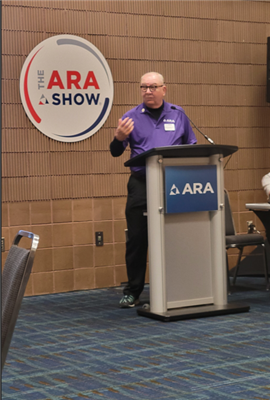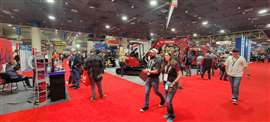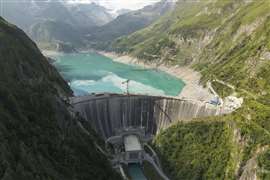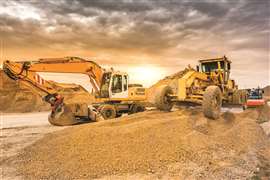Read this article in Français Deutsch Italiano Português Español
5 things we learned at The ARA Show
21 February 2024
The American Rental Association hosted thousands of rental professionals in New Orleans, US this week for the 67th edition of The ARA Show. Officials held a press conference to report the latest economic forecast and to announce the release of new tools and initiatives to benefit the industry. Here are some highlights.
The American Rental Association (ARA) held its annual tradeshow and convention this week, gathering thousands of equipment rental professionals in New Orleans, Feb. 18-21. The organization kicked off the start of the show portion with a press conference to release its latest economic forecast, as well as new initiatives, including a rental sentiment index and media campaign to promote the industry to the workers of tomorrow.
According to officials, the North American rental industry is poised for continued growth with a generally positive outlook, illustrated in part by a return to pre-pandemic rental penetration levels.
Here are five things we learned at The ARA Show this week:
Growth expectations are up
 John McClelland, Ph.D., ARA vice president for government affairs and chief economist, said rental penetration has reached pre-pandemic levels at 56.4%.
John McClelland, Ph.D., ARA vice president for government affairs and chief economist, said rental penetration has reached pre-pandemic levels at 56.4%.
The most current projections indicate a 7.9% increase in year-over-year growth in 2024, totaling $77.3 billion in construction and general tool rental revenue. This is up from last quarter, when year-over-year growth was expected to be 7.6% in 2023 and 3.1% in 2024.
“The ARA Rentalytics quarterly forecast reinforces the strength of the rental industry,” said Tom Doyle, ARA vice president, program development. “Rental should benefit with tailwinds from interest rates, inflation, improving supply, a preference to rent, and government and private spending. Rental revenue is again forecasted to increase.”
Scott Hazelton, director, S&P Global Market Intelligence, the international forecasting firm that compiles data and analysis for the ARA forecast and ARA Rentalytics, said rental is a bright spot in the North American economy.
“In a pretty slow economy we’ve got a pretty good outlook for rental,” he stated. “Why is that? Part of it is overspending on things like the Infrastructure Investment and Jobs Act (IIJA) that are now beginning to peak, giving us some more growth. It’s also the CHIPs Act.”
Despite headwinds from the home building sector, Hazelton said there’s been a seachange in the industry’s outlook.
“Last November/December, we’d rather have high interest rates and kill inflation, even with a recession. In January, we now have things under control and will likely reduce rates this year... we’re looking at record levels of spending.”
Looking more closely at construction and industrial equipment (CIE) growth in the US, projected revenue in 2024 is expected to reach $60.9 billion, which is 7.5% growth. In the coming years - 2025, 2026, and 2027 - 3% growth is projected.
“We see a slowing of growth this year compared to last year but bear in mind, we have a slowing of inflation this year as well,” Hazelton said. “The growth rates tail off in the future years, with growth of 4.3% in 2025 and 3.9% in 2026.”
The current forecast for total Canadian equipment rental revenue shows a 3.1% growth to $974 million in 2024.
Equipment investment will see slower growth
Construction and industrial equipment investment is still forecasting growth, at a rate of 7.2%, but at a slower pace than recent years. The is attributed to the lack of post-Covid investments in 2024.
Outlook for general tool investment in the US is not quite as positive at 6.8%. Manufacturing is driving the growth and housing is still weak.
“ARA’s quarterly member survey showed conflicting results amongst members with just over half of respondents saying they saw a revenue increase in quarter four, a slight improvement over quarter three which saw an even split between those an increase and decrease,” said Mike Savely, ARA director, program development.
Rental penetration reaches pre-pandemic levels
The ARA reported that rental penetration, which is a measure of how much equipment deployed in the marketplace is rented, has reached 56.4%, near the pre-pandemic peak.
“More than half of the equipment that’s out there in the United States is rental equipment,” said John McClelland, Ph.D., ARA vice president for government affairs and chief economist, noting that the ARA’s Rental Penetration Index reached an all-time high of 56.7% in 2019, before dipping to 51.5% the following year due to pandemic-related challenges.
Josh Nickell, ARA vice president of equipment rental, told Rental Briefing late last year that the relationship between uncertainty and rental penetration is never a straight line.
“Any time there’s a shock to the system, like in 2008 or during Covid, we typically see a huge initial drop in rental penetration,” he explained. “Say you’re a construction company with a mixed fleet of owned and rented equipment, and suddenly, things slow down. What fleet disappears first?
“Contractors don’t sell their owned equipment immediately, they stop renting. But the next time they need equipment, they tend to rent vs. buy. Rental penetration then recovers and typically exceeds the previous drop.”
McClelland concluded, “After having that drop in 2020, we’ve gradually been coming back and this year, for all intents and purposes, we are back to pre-pandemic penetration.”
New index measures rental sentiment
To gauge how its members are performing and to get a sense of their expectations for the market, the ARA has introduced its Equipment and Event Rental Segment Index (RSI).
A diffusion index is used by various industries as a barometer. It is a measurement, based on compiled survey response data, of trends and the overall direction a particular industry is headed economically.
 Thousands of rental professionals visited New Orleans, US, Feb 18-21, for the 67th edition of The ARA Show.
Thousands of rental professionals visited New Orleans, US, Feb 18-21, for the 67th edition of The ARA Show.
“We are committed to providing our members with useful research and forecasting inputs,” Doyle said. “We partnered with the industry-leading research firm to provide our membership with another tool that will assist in identifying trends in both the equipment and event segments.”
To develop these diffusion indexes, or RSIs, ARA surveys members whether they see the economic conditions for their rental segment improving or deteriorating during the upcoming quarter:
Responses indicating improving economic conditions are scored with a 100.
Responses indicating worsening economic conditions are scored with a 0.
On each RSI that pulls together members’ responses, an average score of higher than 50 indicates the market is expanding.
The most recent quarter’s Equipment RSI pegged the North American market at 60, indicating positive momentum.
McClelland says it’s important to understand that each rental segment’s RSI is an economic indicator only, not a numbers-based forecast.
“These indexes are not forecasting tools, but rather a measure of current sentiment as expressed by market participants,” McClelland said. “There is also not a direct link between levels of the index and, say, revenues. For example, a reading of 75 does not imply a 20% increase in revenues over a reading of 55. However, a reading of 75 certainly indicates a significantly stronger market sentiment than a reading of 55.”
The RSIs from ARA are developed with the assistance of S&P Global Market Intelligence, the international forecasting firm that compiles data and analysis for ARA’s Rentalytics members-only subscription service. Findings from the RSIs are presented in ARA’s quarterly economic forecasting webinars, available to Rentalytics subscribers.
ARA debuts ‘Born for This’ campaign
The ARA debuted a new campaign at the show with the hopes of cultivating a new generation of skilled workers for the industry. Titled “Born For This,” the campaign will include videos and other media designed to encourage young people to pursue a career in the trades and to consider equipment rental as a lucrative career choice. More details to come.
STAY CONNECTED


Receive the information you need when you need it through our world-leading magazines, newsletters and daily briefings.
CONNECT WITH THE TEAM











